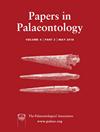On the occurrence of rare nannoliths (calcareous nannofossils) in the Early Jurassic and their implications for the end‐Triassic mass extinction
IF 2.3
2区 地球科学
Q1 PALEONTOLOGY
引用次数: 1
Abstract
A peculiar record of previously undescribed and/or rarely described nannoliths from the Hettangian to lower Pliensbachian of the Llanbdr (Mochras Farm) core, Wales (UK) is documented here. Some of the observed morphotypes are assigned to didemnid ascidians, commonly observed in the upper Rhaetian, as evidence of the resilience of ascidian tunicates during the end‐Triassic mass extinction. One newly described nannolith present throughout the Hettangian and Sinemurian, Quadrifolium hesselboi, is similar to forms previously observed in the upper Rhaetian, and is therefore considered to be a new nannofossil survivor from the end‐Triassic mass extinction. High‐amplitude changes observed in the absolute and relative abundances of nannoliths, schizosphaerellids and coccoliths across the Hettangian suggest a recovery interval from the end‐Triassic crisis spanning the planorbis–liasicus ammonite zones in four distinct steps with high volatility in environmental conditions, followed by the establishment of more stable environmental conditions in the angulata ammonite zone.早侏罗世罕见的纳米石(钙质纳米化石)的出现及其对三叠纪末大灭绝的意义
这里记录了来自威尔士(英国)Llanbdr (Mochras Farm)岩心的Hettangian到Pliensbachian下的一种以前未被描述和/或很少被描述的纳米石器的特殊记录。一些观察到的形态类型被分配给了在上雷蒂亚地区常见的didemnids海鞘,作为三叠纪末大灭绝期间海鞘动物恢复能力的证据。在Hettangian和Sinemurian中发现了一种新发现的纳米化石,即Quadrifolium hesselboi,它与之前在上雷蒂亚(Rhaetian)中观察到的形式相似,因此被认为是三叠纪末大灭绝时期的新纳米化石。在Hettangian观察到的纳米岩、裂球石和球岩的绝对丰度和相对丰度的高振幅变化表明,在环境条件高度波动的四个不同步骤中,从三叠纪末的危机中恢复了planoris - liasicus菊石带,随后在angulata菊石带建立了更稳定的环境条件。
本文章由计算机程序翻译,如有差异,请以英文原文为准。
求助全文
约1分钟内获得全文
求助全文
来源期刊

Papers in Palaeontology
PALEONTOLOGY-
CiteScore
4.50
自引率
4.30%
发文量
55
期刊介绍:
Papers in Palaeontology is the successor to Special Papers in Palaeontology and a journal of the Palaeontological Association (www.palass.org). The journal is devoted to the publication of papers that document the diversity of past life and its distribution in time and space.
Papers in Palaeontology is devoted to the publication of papers that document the diversity of past life and its distribution in time and space. As a sister publication to Palaeontology its focus is on descriptive research, including the descriptions of new taxa, systematic revisions of higher taxa, detailed biostratigraphical and biogeographical documentation, and descriptions of floras and faunas from specific localities or regions. Most contributions are expected to be less than 30 pp long but longer contributions will be considered if the material merits it, including single topic parts.
The journal publishes a wide variety of papers on palaeontological topics covering:
palaeozoology,
palaeobotany,
systematic studies,
palaeoecology,
micropalaeontology,
palaeobiogeography,
functional morphology,
stratigraphy,
taxonomy,
taphonomy,
palaeoenvironmental reconstruction,
palaeoclimate analysis,
biomineralization studies.
 求助内容:
求助内容: 应助结果提醒方式:
应助结果提醒方式:


